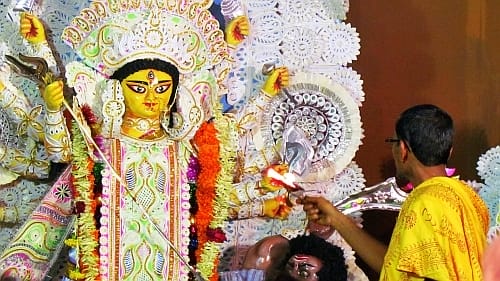The festive atmosphere of the Dushera/Navarathri season was very apparent at the Durga Puja Pandal on Bannerghatta Road.
At NGR Kalyana Mantapa, on Bannerghatta Road, the South Bangalore Cultural Association, under its President, S Lahiri, began the Pujo festivities on Shasthi (sixth day after the new moon), which fell on 2nd October.
Several cultural programmes were scheduled for the festivities up the 6th of October, when the idol of Durga was taken in ceremonial procession for "Bisarjan" or immersion, after the worship. Indrashis De Sarkar, a very active volunteer, says smilingly that this Pujo is as old as his marriage! He remembers bringing an image from Kumartuli the first time. Now, a group of artisans come over from West Bengal, three months ahead, and make the images in Ulsoor. The priests are also from Kolkata.
This year, he says, the emphasis for the cultural events was on various bands from Kolkata, such as ‘Indian Blues’ and ‘Maseeha’. There was also a Bangalore band, ‘7 Sur’, on Monday evening. Every evening there were dance performances, too. Lunch and dinner, consisting of the traditional Bengali bhog, was served free to devotees. There were also the food stalls set up outside. "Contributions from well-wishers, and corporates, are what enable us to conduct the Pujo each year," adds Lahiri.

Chat stall at SBCA Durga pandal. Pic: Deepa Mohan
Alakananda, who came to visit the Pujo all the way from Sadashiva Nagar, was very impressed with the dance performance that evening. “Pujo is a great occasion to showcase the talent of many of our youngsters,” she smiled.
White and red are the predominant colours of the sarees that the Bengali women wore. Though the traditional Bengali way of wearing the saree (with a keychain tied to the end of a pallu, thrown over a shoulder) was no longer in evidence, even with the older women, the beautiful Bengal cottons were very much in evidence. So, too, was the traditional jewellery of Bengal. The shaankh (bangles made from cross-sections of conch shells) and pola (bangles of lac) were augmented with other haar (necklaces) and choodi (bangles), noopoor (anklets) and kaaner phool (earrings) of every description.
Many men wore the dhuti paanjaabi (dhoti and kurta); the traditional tucking-into-the-pocket of the pleated end of a starched dhuthi was not to be seen. Joothi (traditional footwear) was still seen on some feet….but I didn’t spot aalta, the flower-based red dye for the feet.
I gorged myself on jhaal mudi, puchka (the Bengali equivalent of pani puri) and singhaada (Bengali samosas), and ate a few sondesh and ….how could I miss it?….rosogolla, that essence of Bengali-dom! I looked for chaa (tea) in bhaand (mud cups that can be smashed afterwards) but did not find any.
The chatter and hubbub of people meeting and greeting each other, the notes of the musicians and the anklets of the dancers, and the beat of the dhaakiya when the worship started….it took me back to my life in Kolkata.
I also went to visit the Pujo organized by the Bengali in Bangalore Society, at AICOBOO Nagar, in BTM Layout. I was quite impressed by the idols chosen, in the traditional idiom, which had a lot of hand-crafted pith work as ornamentation. The devotees all stood as the evening Arati was performed by the priest. The lighting, with the necessary generator backup, was well executed. However, being a younger group, it was obvious that the pandal was suffering from some teething pangs.

The Durga idol at the BTM AICOBOO grounds celebrations. Pic: Deepa Mohan
The open-air venue was extremely muddy. and the few stalls that had been set up could not even be reached, even though granite chips had been spread over the muddy ground. Also, the caterers’ offerings fell well below the mark.The traditional Bengali dishes like Luchi and Alur Dom, though advertised were not available, and the cold singhadas were not very appealing. In spite of this, it was a creditable effort by the "Bengali in Bangalore" group, and we wish them every success in the coming years!
On Dasami Day, I visited the pandals again…both venues wore a forlorn, desolate look after the end of the festivities. At N G R Kalyana Mantapa, a group of women were sweeping up the debris, under the supervision of some of the volunteers. This follow-up cleaning was very impressive. A van had come to take away the chairs, and the decorations….an empty hall, echoing with the memories of the chatter of the crowds, waited to serve its turn and welcome the Mother Goddess again, in the years to come.⊕